MASH vs CATCH-22: 45 Years Later
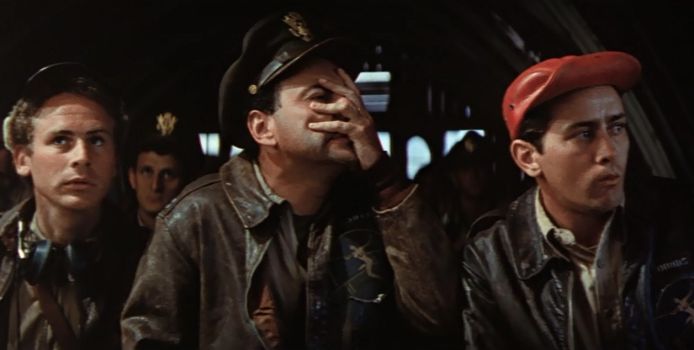
Lapsed scriptwriter and dad, currently failing to encourage my children…
With a Finger in Each Ear, We March Blindly On
The Vietnam War, which had begun as a geopolitical chess match in the 1950’s, escalated into a full blown land war in 1965 when President Lyndon Johnson authorised the use of American ground troops to help South Vietnam defeat the Communist North. More than any conflict in the 20th Century, Vietnam segregated America into a civil war of ideals. The burgeoning counterculture rejected and rallied against it, even denouncing the troops themselves. Universities around the world were overrun by disaffected students intent on social revolution, who viewed US involvement in Vietnam as the world’s central and most heinous injustice. By 1968, news of the Tet offensive and the infamous Mai Lai massacre had been fed back to the folks at home. Walter Cronkite, the most trusted figure on US television said that: “To say that we are mired in a stalemate seems the only realistic, yet unsatisfactory conclusion,” and went on to suggest that a negotiated retreat was the only solution. How did Hollywood respond to these years of divisive violence and bloodshed? Musicals. Lots of musicals. And The Green Berets.
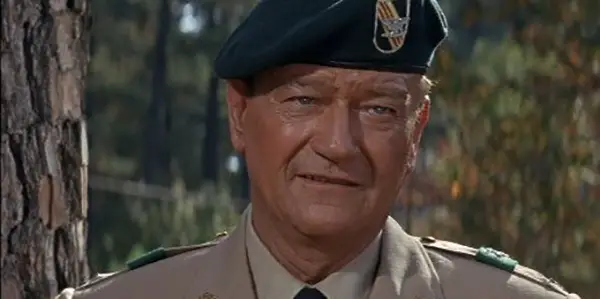
In his gung-ho adaptation of Robin Moore’s book, John Wayne sought to reintroduce the spirit of D-Day as a means to quelling the hippies’ discontent. The hostile critical reception that awaited The Green Berets, particularly from returning infantrymen, is legendary. Ask Oliver Stone what he thought of it, then stand well back. To watch The Green Berets today is a truly bewildering, dispiriting and disjointed experience; somehow hilarious and depressing. But it is often forgotten that in 1968, it was one of the biggest box office hits of the year. Hollywood listened as rebellious youth chanted a song of rage, while the silent majority paid a fortune to see John Wayne kicking Charlie’s ass. Which way to turn? In time-honoured fashion, Hollywood zipped up its mouth and said nothing.
The Times, They Were A-Changing
If Vietnam was taboo: a potential rose too damn thorny to grasp, the new anti-establishment generation inside Hollywood found other ways to vent spleen without direct reference to their nemesis. The most important picture, the one that really announced the ‘New Hollywood’, was Arthur Penn’s Bonnie and Clyde, which showcased a pair of sociopathic murderers and held them up as sexy folk heroes for the audience to cheer. The film was a milestone in the story of cinematic violence, and though our “heroes” are punished, as though to fulfill a Hays code obligation, they die in an R-rated orgy of gunfire and jets of slow-motion blood. Faye Dunaway is even allowed a sensual intake of breath before being gunned down, suggesting that this carnage may provide her with the kind of sexual thrill her impotent lover was unable to offer.
In its wake, a slew of raw and angry motion pictures roared into view: Sam Pekinpah’s The Wild Bunch, Peter Bogdanovich’s Targets, George A. Romero’s Night of The Living Dead, Dennis Hopper’s Easy Rider and John Schlesinger’s sexually explicit, X-rated Midnight Cowboy, which won the 1969 Best Picture Award. More importantly than the zeitgeist-capturing, the game-changing and the acclaim – these films made a fortune. They succeeded at a time when lavish, expensive post-Sound of Music extravaganzas like Star!, Doctor Dolittle and Half a Sixpence were failing on a studio-bankrupting scale. New Hollywood rolled a joint, held up a peace sign and dived full tilt into the counterculture.
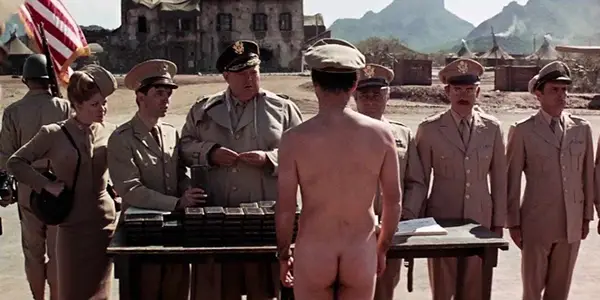
If you’re going to make the ultimate anti-war movie, it stands to reason, why not adapt the ultimate anti-war novel, and Paramount had the rights to Joseph Heller’s 1961 classic Catch-22. Acclaimed as a masterpiece upon release, Catch-22’s reputation had grown exponentially ever since. Its titular sub-clause had taken on a life of its own, entering the language and summing up the infuriating, imprisoning nature of bureaucracy at its most twisted and malicious.
‘…a concern for one’s safety in the face of dangers that were real and immediate was the process of a rational mind. (He) was crazy and could be grounded. All he had to do was ask; and as soon as he did, he would no longer be crazy and would have to fly more missions. (He) would be crazy to fly more missions and sane if he didn’t, but if he were sane he had to fly them. If he flew them he was crazy and didn’t have to; but if he didn’t want to he was sane and had to.’ (Source: Catch-22 by Joseph Heller. Publisher: Simon & Schuster)
Paramount stopped at nothing to make this the greatest and most important anti-war movie ever made. A colossal $17 million budget was put in place, a hefty ratio of which was spent on aerial sequences with real WWII B-25 Mitchells. A large set was built in Mexico – subbing for the Mediterranean island of Pianosa – and peopled with an impressive cast: Jon Voight, Anthony Perkins, Bob Newhart, Martin Balsam, and Charles Grodin. Alan Arkin headed up as Captain Yossarian, whose doomed attempts to get himself grounded hold the film together, while Art (or Arthur) Garfunkel made his acting debut. As a final stamp of quality, cinema legend Orson Welles (who had tried and failed to get his own version off the ground) was shipped in for a cameo as General Dreedle.

The ringmaster hired by producer Jon Calley was the now sadly late Mike Nichols, at that time the hottest director in Hollywood. He’d become a star by way of a comic partnership with Elaine May, and they were regarded as the best comedy writers in the business. He stepped behind the cameras for the first time in 1966 with the fraught drama Who’s Afraid of Virginia Woolf?, which won five Oscars. He followed this with The Graduate, a zeitgeist-defining comic masterpiece that won him the Best Director Oscar in 1968 and was one of the year’s biggest hits.
Nichols’s mastery of both drama and comedy, and his ability to blend the two sympathetically made him the perfect choice for this project. He even brought in his acclaimed Graduate scriptwriter Buck Henry to translate Heller’s spiraling non-linear prose into something close to a formal narrative. The suits at Paramount sat back in their leather chairs, lit cigars and started practising their acceptance speeches…
…unaware that a 44-year-old television director and a handful of barely recognisable actors were shooting a picture on the Malibu lot outside Fox Studios in Los Angeles that effectively loaded a torpedo and pointed it in Catch-22’s direction.
Enter Altman
Robert Altman had made a career directing popular television shows like Bonanza, Combat! and Kraft Suspense Theatre, but he was desperate to break out of the TV studio and direct motion pictures. His first attempts, That Cold Day in The Park and sci-fi Countdown with a young James Caan, made little impression on the public, and his reputation as a combative, argumentative cuss didn’t help. If 20th Century Fox had any idea that a script by a former blacklisted scriptwriter based on a novel few people had heard of would become an American phenomenon, there is no goddamn way they would have handed MASH to a man like Robert Altman. But as soon as he saw an early draft of Ring Lardner’s script, Altman knew that he had to have it.

In the years since MASH, the director’s unique style; the scattershot narrative flow, the overlapping, often unintelligible dialogue, has earned its own name – few reviews of Paul Thomas Anderson’s early work exist without the word ‘Altmanesque’ crow-barred in. It’s astonishing then to see his style so immediately and successfully implemented in MASH. Many of the actors had no idea what was going on. Donald Sutherland and Elliott Gould famously tried to have Altman fired, until they started seeing the dailies and realised their director wasn’t as insane at they thought.
The shoot was a laid-back affair, wreathed in pot smoke and cold beers, which contributed enormously to the seemingly effortless performances of the ensemble cast. This coolness didn’t hide the bellyful of anger and indignation that Altman and most of the cast felt about the Vietnam conflict. Though the film is set during the Korean War, Altman removed any mention of the country by name, hoping to bypass metaphor in favour of straight commentary. They only had to mention it after the studio absolutely insisted that the caption ‘Korea’ was added at the start of the film, to Altman’s fury. More than anyone, even more than Nixon, Altman hated the studio executives who interfered whenever they could. This gave the film its vital, throbbing anti-establishment heart. As Peter Biskind put it in the masterful book called Easy Riders, Raging Bulls, ‘MASH was a “f*ck you” from the cool to the uncool.’
“Caught 22”
With the shooting of Catch-22 complete and a June release date locked in, Mike Nichols and Jon Calley went to an early screening to see a new anti-war army comedy that some poor schmuck had foolishly put out before their own superlative anti-war army comedy. Peter Biskind wrote, ‘Right away, however, Nichols got a tight feeling in his chest as Altman’s darkly comic vision played out in front of him, recognising that he had been blindsided. “We were waylaid by MASH, which was fresher and more alive, improvisational, and funnier than Catch-22,” he says. “It just cut us off at the knees.”’ (Source: Easy Riders, Raging Bulls by Peter Biskind. Published by Bloomsbury)
MASH was a colossal hit, making $81m off a $3.5m budget. Opening in March 1970, it had a three-month jump on Catch-22, which failed to make back its budget and received poor notices. Its release, so close to that of MASH, suggested another round of bird-flipping high jinks, so Catch-22’s bleak, tragicomic surrealism left audiences mystified and bemused. Most of them most likely went back to watch MASH again.
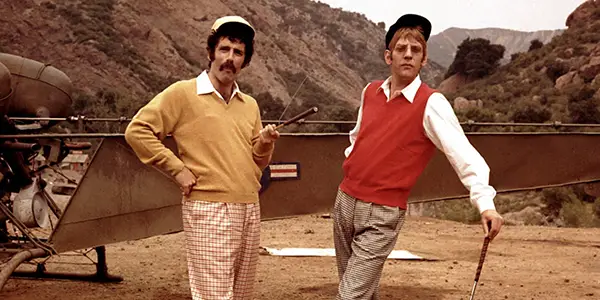
Crucially, Catch-22 just wasn’t funny. Where MASH was a jazz score of effortless riffs, hung out on the loosest of plots, Catch-22 at times felt like Michelangelo Antonioni had been given $17 million to make an episode of The Phil Silvers Show. The film was loud – war-loud, with comic dialogue often fighting against the roar of B52 engines. Alan Arkin’s constant screaming became very tedious very quickly; all the more so now that everyone was used to the beatnik, Ivy-League cool of Trapper and Hawkeye. Trapper’s introduction, producing a jar of olives from his coat and dropping one into his martini, amidst the squalid mire of Hawkeye’s muddy bed-tent, is an essay in the comedy of restraint. There is nothing in Catch-22 (or most comedies of the past 45 years) to match the lovely touch when a rival football player is injected with a sedative in the middle of a scrum, but not before his skin is given a dainty little wipe with some surgical cloth.
Catch-22, perhaps, was buried under too much weight: the imposing significance of the book and the leaden thumb press of enormous studio expectation, along with the concomitant budget bloat. Twenty years later, Brian de Palma trod a similar path when he brought another Generation-Defining Great American Novel™ to the screen: in this case The Bonfire of The Vanities, which went through a studio cheese-grater and came out a $47 million sex farce with no laughs and nothing interesting to say.
In Retrospect…
As a major, portentous Academy-baiting studio movie, Catch-22 was the respectable paterfamilias, whereas MASH was the c*cky teenager telling his parents to go f*ck themselves. Time, however, has been kind to Nichols’s folly. One can attribute its initial failure to a completely false expectation raised by the success of MASH. Would The Outlaw Josey Wales have been a hit had the audience of Blazing Saddles not shown up expecting another round of horse punching and fart jokes? Allowed to exist on its own terms, Nichols’s Catch-22 has matured into a unique and often extraordinary work, albeit one that was rarely mentioned in his many effusive obituaries last year.
Far from emulating the comic mischief of MASH, the movie Catch-22 actually most resembles is Richard Lester’s little seen The Bed Sitting Room (shot, like Catch-22 by the stunningly gifted British cinematographer David Watkins). Both films are hallucinatory, fragmented, absurdist works, fever dreams spinning surreal comedy from enormous tragedy. Nichols’s brave decision to remove all the extras from the vast set creates a similar feeling of theatre-in-the-round. Often, there are plays within the play. Bob Newhart’s scene as Major Major, who will only see people if he is not in his office to see them (note the portrait on the wall changing each time Major passes it) could have been ghost written by Samuel Beckett.
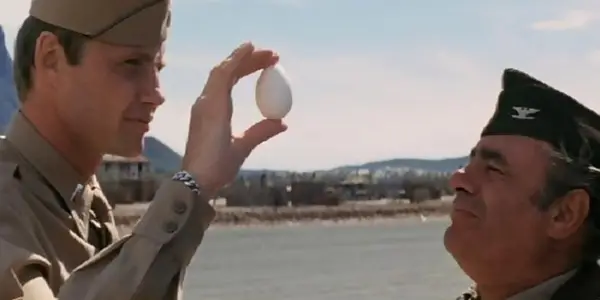
Watkins is the film’s secret weapon. He uses sunlight here like oil paint, and the smell of sweat and diesel rises in your throat as you watch it. The cast performs out of their collective socks. Charles Grodin is a stand-out as the dapper, unflappable and ultimately murderous Captain “Aardvark” Aarfy. Jon Voight’s Milo Minderbender develops from a bright-eyed, enterprising apprentice, to a callow, Aryan, inhuman CEO, having traded all of the camp’s essentials (including Yossarian’s parachute) to swell the coffers of his M&M Enterprises.
Joseph Heller himself professed to be a fan of the movie. On the DVD commentary, Stephen Soderbergh sits at the foot of Mike Nichols like an eager puppy, very often more dazzled by the artistry on display than Nichols himself. In pre-CGI 1970, the airborne scenes are especially impressive. One wordless, two-minute scene featuring about fifteen B52 bombers taking off into the air at the same time, achieves a hypnotic sense of childish wonder that $200m Pearl Harbor couldn’t buy 31 years later.
There is a final pleasing irony too that in the television show that M*A*S*H eventually became, a new and suspiciously familiar character was added. Corporal Klinger repeatedly attempts to get himself sectioned (usually by turning up to work in a dress) as a means to getting out of the army, a means that invariably fails. Sound familiar? Catch-22 may have lost the box-office war, but its influence hit close to home and has lasted to this day – which is more than can be said for The Green Berets.
Which other famous movie face-offs do you think warrant closer examination? Wyatt Earp vs Tombstone, maybe? Always vs Ghost? Deep Impact vs Armageddon? Batman vs Sup… Oh no, that’s next year.
(top image Catch-22 (1970) – source: Paramount Pictures)
Does content like this matter to you?
Become a Member and support film journalism. Unlock access to all of Film Inquiry`s great articles. Join a community of like-minded readers who are passionate about cinema - get access to our private members Network, give back to independent filmmakers, and more.
Lapsed scriptwriter and dad, currently failing to encourage my children to watch black and white films. Alter-ego: a mild-mannered restaurateur in north Wales. Have been writing about films and food for three years in magazines like Cinema Retro and The Chap, and on websites like HeyUGuys.com and Taste of Cinema. Obsessed by cinema in all its forms.













